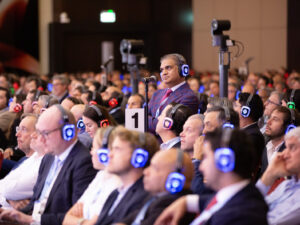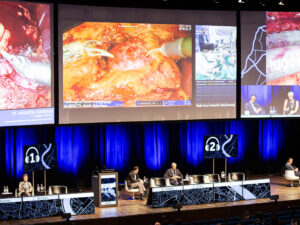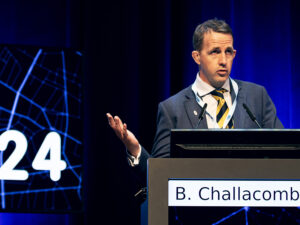During the roundtable on telesurgery on the first day of ERUS24 in Bordeaux, the panel was uniquely qualified to offer their opinions and observations, as representatives of a tiny group of Western urologists with hands-on experience in telesurgery.
Prof. Vip Patel (Celebration, US) led the discussion and was keen to show the progress he had witnessed and indeed experienced these past few months.
Technologies involved
The session started with an explainer of the technological underpinnings of telesurgery by Mr. Mischa Dohler, VP of Emerging Tech at Ericsson Inc and expert in 5G/6G, AR and Generative AI. He explained the “eco-system play”, and how telesurgery factors could be classified. Data rate, round-trip latency and service levels of the connection could each be classified into three categories, leading to ratings like AAA, BAA, ABB, and so forth. This framework can calibrate capabilities and help with regulatory requirements when telesurgery is adopted more broadly.
While 5G is often mentioned as a key development into making telesurgery feasible, it is in fact mostly a (mandatory) fall-back for fibre connections. With diagrams he explained the nature and interplay of the different connections at work during a telesurgical procedure, while also explaining how latency builds up at different points in the connection. Altogether, telesurgery is a very realistic proposition at low latencies in the distances of 800-2500 miles (1300-4000km), which is enough to cover all US states.
According to Mr. Dohler, the first business cases for telesurgery will most likely be within the same healthcare system (hospital groups), which are often within the same state.
Implications and applications
From his own “hands-on” experiences with remote surgery within China and between his centre in Orlando and China, Prof. Patel shared some insights.
The possibilities offered by remote surgery had “a lot of breadth,” according to Patel. “What could a surgeon do remotely? You would find that you no longer have to be at every remote location for operating or for teaching.”
“Now that new robotic systems have entered the market, telesurgery has accelerated. Most new systems that have recently come to market are tele-capable, as are many that are already on the market.”
“Telesurgery has the potential to equalise geographic disparity of healthcare,” Prof. Patel said, giving examples of governments in lower-income countries investing in robotic systems and telesurgery to accelerate adoption and (remote) training of surgeons and staff.
In order to best guide the global efforts to achieving reliable and sustainable telesurgery, Prof. Patel introduced the Telesurgery Collaborative Community Working Group, which features leading experts from different scientific societies (including ERUS). He also referred to the “ten commandments of telesurgery” that were drawn up to provide guidelines for ethical adoption of telesurgery.
Prof. Patel then detailed his own experiences with the new Chinese robotic systems that are leading the adoption of telesurgery in China. Prof. Patel compared the systems to established brands, saying there was little to no learning curve for experienced surgeons. He gave an example of surgery performed on animals over a distance of 13,000 kilometers, between Orlando and Shanghai, with twelve successful partial nephrectomies performed so far.
Training opportunities
Prof. Marcio Covas Moschovas (Celebration, US) highlighted the educational potential of telesurgery, with experienced surgeons taking over mid-procedure to guide their juniors or perform a certain challenging step.
“Imagine one expert disseminating his personal surgical technique around the world, first-hand!” Prof. Moschovas threw to the audience, before pointing out that this was new ground in the literature. There were no articles assessing the role of telesurgery in the improvement of robotic training. “It’s up to us to write these pages,” said Moschovas.
He then showed recordings of multiple surgeons working in turn, remotely, on the same patient, stepping in and out when the procedure required it.
The session concluded with some further panel discussion. Prof. Declan Murphy (Melbourne, AU) observed obvious benefits in availability for surgeons: no longer bound by logistical challenges and time spent in transit. Relieving surgeons of this would allow for telementoring, training novice colleagues abroad as part of a regular working day.
Prof. Murphy: “This is an extreme extension of what we discovered during covid: telehealth is feasible and it’s here to stay. This next step is the combination of rapid developments in communications technology, together with a new generation of affordable robots being produced in China and adopted in countries that currently have no robotic systems or qualified surgeons. These two revolutions coming together, telesurgery meets that right in the middle.”





